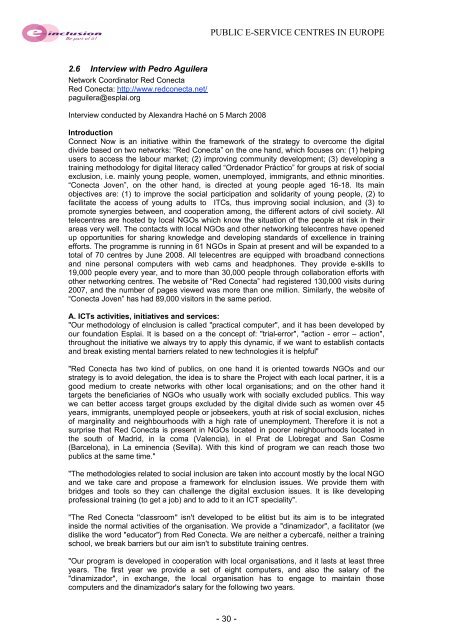Comparative Study of Public e-Service Centres in - ePractice.eu
Comparative Study of Public e-Service Centres in - ePractice.eu
Comparative Study of Public e-Service Centres in - ePractice.eu
You also want an ePaper? Increase the reach of your titles
YUMPU automatically turns print PDFs into web optimized ePapers that Google loves.
2.6 Interview with Pedro Aguilera<br />
Network Coord<strong>in</strong>ator Red Conecta<br />
Red Conecta: http://www.redconecta.net/<br />
paguilera@esplai.org<br />
Interview conducted by Alexandra Haché on 5 March 2008<br />
PUBLIC E-SERVICE CENTRES IN EUROPE<br />
Introduction<br />
Connect Now is an <strong>in</strong>itiative with<strong>in</strong> the framework <strong>of</strong> the strategy to overcome the digital<br />
divide based on two networks: “Red Conecta” on the one hand, which focuses on: (1) help<strong>in</strong>g<br />
users to access the labour market; (2) improv<strong>in</strong>g community development; (3) develop<strong>in</strong>g a<br />
tra<strong>in</strong><strong>in</strong>g methodology for digital literacy called “Ordenador Práctico” for groups at risk <strong>of</strong> social<br />
exclusion, i.e. ma<strong>in</strong>ly young people, women, unemployed, immigrants, and ethnic m<strong>in</strong>orities.<br />
“Conecta Joven”, on the other hand, is directed at young people aged 16-18. Its ma<strong>in</strong><br />
objectives are: (1) to improve the social participation and solidarity <strong>of</strong> young people, (2) to<br />
facilitate the access <strong>of</strong> young adults to ITCs, thus improv<strong>in</strong>g social <strong>in</strong>clusion, and (3) to<br />
promote synergies between, and cooperation among, the different actors <strong>of</strong> civil society. All<br />
telecentres are hosted by local NGOs which know the situation <strong>of</strong> the people at risk <strong>in</strong> their<br />
areas very well. The contacts with local NGOs and other network<strong>in</strong>g telecentres have opened<br />
up opportunities for shar<strong>in</strong>g knowledge and develop<strong>in</strong>g standards <strong>of</strong> excellence <strong>in</strong> tra<strong>in</strong><strong>in</strong>g<br />
efforts. The programme is runn<strong>in</strong>g <strong>in</strong> 61 NGOs <strong>in</strong> Spa<strong>in</strong> at present and will be expanded to a<br />
total <strong>of</strong> 70 centres by June 2008. All telecentres are equipped with broadband connections<br />
and n<strong>in</strong>e personal computers with web cams and headphones. They provide e-skills to<br />
19,000 people every year, and to more than 30,000 people through collaboration efforts with<br />
other network<strong>in</strong>g centres. The website <strong>of</strong> “Red Conecta” had registered 130,000 visits dur<strong>in</strong>g<br />
2007, and the number <strong>of</strong> pages viewed was more than one million. Similarly, the website <strong>of</strong><br />
“Conecta Joven” has had 89,000 visitors <strong>in</strong> the same period.<br />
A. ICTs activities, <strong>in</strong>itiatives and services:<br />
"Our methodology <strong>of</strong> eInclusion is called "practical computer", and it has been developed by<br />
our foundation Esplai. It is based on a the concept <strong>of</strong>: "trial-error", "action - error – action",<br />
throughout the <strong>in</strong>itiative we always try to apply this dynamic, if we want to establish contacts<br />
and break exist<strong>in</strong>g mental barriers related to new technologies it is helpful"<br />
"Red Conecta has two k<strong>in</strong>d <strong>of</strong> publics, on one hand it is oriented towards NGOs and our<br />
strategy is to avoid delegation, the idea is to share the Project with each local partner, it is a<br />
good medium to create networks with other local organisations; and on the other hand it<br />
targets the beneficiaries <strong>of</strong> NGOs who usually work with socially excluded publics. This way<br />
we can better access target groups excluded by the digital divide such as women over 45<br />
years, immigrants, unemployed people or jobseekers, youth at risk <strong>of</strong> social exclusion, niches<br />
<strong>of</strong> marg<strong>in</strong>ality and neighbourhoods with a high rate <strong>of</strong> unemployment. Therefore it is not a<br />
surprise that Red Conecta is present <strong>in</strong> NGOs located <strong>in</strong> poorer neighbourhoods located <strong>in</strong><br />
the south <strong>of</strong> Madrid, <strong>in</strong> la coma (Valencia), <strong>in</strong> el Prat de Llobregat and San Cosme<br />
(Barcelona), <strong>in</strong> La em<strong>in</strong>encia (Sevilla). With this k<strong>in</strong>d <strong>of</strong> program we can reach those two<br />
publics at the same time."<br />
"The methodologies related to social <strong>in</strong>clusion are taken <strong>in</strong>to account mostly by the local NGO<br />
and we take care and propose a framework for eInclusion issues. We provide them with<br />
bridges and tools so they can challenge the digital exclusion issues. It is like develop<strong>in</strong>g<br />
pr<strong>of</strong>essional tra<strong>in</strong><strong>in</strong>g (to get a job) and to add to it an ICT speciality".<br />
"The Red Conecta ''classroom'' isn't developed to be elitist but its aim is to be <strong>in</strong>tegrated<br />
<strong>in</strong>side the normal activities <strong>of</strong> the organisation. We provide a "d<strong>in</strong>amizador", a facilitator (we<br />
dislike the word "educator") from Red Conecta. We are neither a cybercafé, neither a tra<strong>in</strong><strong>in</strong>g<br />
school, we break barriers but our aim isn't to substitute tra<strong>in</strong><strong>in</strong>g centres.<br />
"Our program is developed <strong>in</strong> cooperation with local organisations, and it lasts at least three<br />
years. The first year we provide a set <strong>of</strong> eight computers, and also the salary <strong>of</strong> the<br />
"d<strong>in</strong>amizador", <strong>in</strong> exchange, the local organisation has to engage to ma<strong>in</strong>ta<strong>in</strong> those<br />
computers and the d<strong>in</strong>amizador's salary for the follow<strong>in</strong>g two years.<br />
- 30 -
















